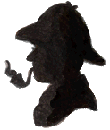 Whodunnit?
Whodunnit?
 Whodunnit?
Whodunnit?
A Unit on Mysteries and Forensic Science
for elementary gifted students
Created by Susan Seagraves
http://www.geocities.com/Athens/Atrium/5924/index.html
Please feel free to modify this unit in any way to best fit into your curriculum. This unit is designed to complement your science and/or literature curriculum. At the completion of the unit the students will be able to write their own mysteries based on their knowledge of forensic science and critical thinking skills.
The lessons are divided into three areas:
Mysteries in literature
Critical Thinking skills
Forensic Science

Introducing the Unit
To begin this unit with students in grades 4-6, I show the video The Hound of the Baskervilles starring Jeremy Britt. Each of the students has a detective's notebook in which they record clues during the video. I pause before the end and we discuss who we think committed the crime and why. I then show the ending of the video. For younger students I recommend the video The Great Mouse Detective or the Wishbone series Hound of the Baskervilles video. We then read a short synopsis of the history of the mystery. The last activity I do the first day is to have each of the students create a Wanted Poster about themselves. They draw both front and profile views of themselves and write descriptions. I only allow positive comments on the posters. We then display the posters all over the room, as they will all be "suspects" in the crimes we solve in the forensic science activities.

Weekly Activities
Each week we do activities from the three areas I focus on in the unit. You can click on the links below to see the individual activities for each area.

Concluding Activities
I have two concluding activities for this unit. The first is a Mystery Festival where I set the stage for the crime scene. All of the evidence is placed in the classroom and the area is roped off with crime scene tape which I get from the local police department. The students use their critical thinking skills and knowledge of forensic science to solve the case. I have found a book called Mystery Festival which is published by the Lawrence Hall of Science. It has two mysteries, one for younger students about a missing teddy bear, and another for older students involving a murder. These activities are so wonderful that I have not taken the time to create one myself. Mystery Festival is listed in the resource section of this unit.
The second concluding activity is a book signing party. As part of the Mysteries in Literature segment of the unit, each of the students write a mystery of their own. Students work on the mystery each week and then we bind them into book form. Each student makes 10 copies of their book and we have a book signing party. At the party everyone dresses as their favorite detective. Parents, teachers, and community members are invited and may "purchase" copies of the students' book which they autograph.

Evaluation
The activities are evaluated in a number of ways. I use rubrics for many of the group forensic science activities. Most of the critical thinking activities are done as a class activity, so I look at class participation. I evaluate the writing activities by looking at elaboration of sentences and ideas; originality of the story; and grammar, punctuation, and spelling.
![]() Mystery
and Forensic Science links on the Net
Mystery
and Forensic Science links on the Net
Copyright © 2000 S. Seagraves